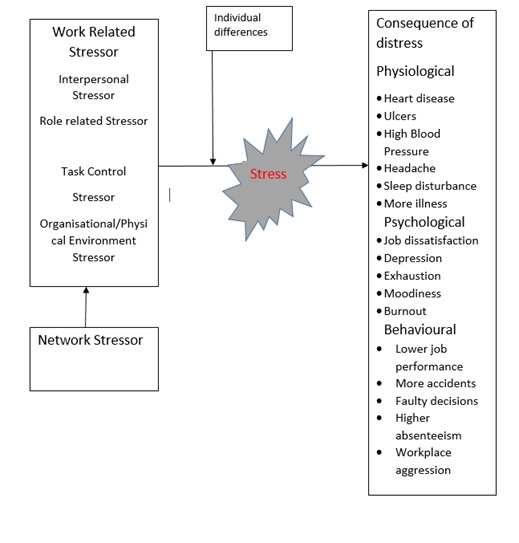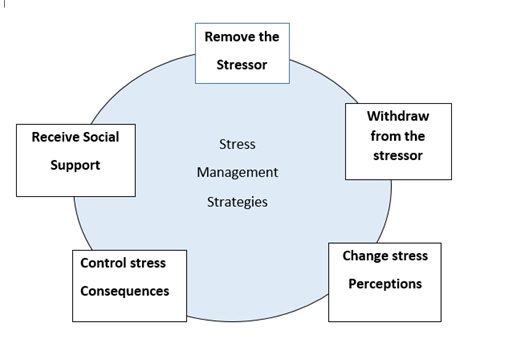Work Stress And Stress Management (Organisational Behaviour and Design)
Stress is a general feature in human existence. It is not related to specific culture, though it is experienced by humans in varied form and intensity. Each stressful experience reminds people that their world is not altogether stable and that, no matter how well we fortify our defences, the unexpected, even the unthinkable, can happen (Alex J. Zautra). Stress in organizations is a wide-spread fact with extensive practical and economic consequences. Organizational stress is assumed to be related to increased absenteeism.
Dr. Hans Selye defined stress in 1942. He stated that stress is a non-specific response of the body to any demand made on a person. He believed that when a person is under stress a set of symptoms of the body get manifested in the form of headache and backache. Workplace stress can be explained as the change in one's physical or mental state in response to workplaces that pose an appraised challenge or threat to that employee. Generally, there are four stress concepts such as the stimulus concept; the response concept; the transactional concept; and the discrepancy concept. The stimulus concept focuses on situational conditions or events. In this concept, certain stimuli are stressful, for example high time pressure, interpersonal clash at work, or accidents. However, the stimulus concept is challenging because not all individuals react in a consistent manner to the same stressor. Nearly every situational condition or every event may evoke strain in some individuals. The reaction concept focuses on physiological reactions as a crucial constituent of stress, i.e. stress exists if an individual shows a specific reaction pattern, irrespective of situational characteristics (Selye, 1956). However, this type of stress also has its limitations. It does not take into account that very different situations can results in the same physiological responses and that an individual's coping efforts may have an effect on this individual's reactions, thus altering the stress response.
Another category of concepts refers both to the situation and the person when defining stress. The transactional concept defined by Lazarus (1966) supposes that stress results from a transaction between the individual and the environment, including the individual's perceptions, expectations, interpretations, and coping responses. The discrepancy concept explains stress as an incongruence between what individual's desires and the environment (Edwards, 1992). However in operationalizing such a discrepancy, researchers face great difficulties. One of the most important models of stress process is the transactional model of Lazarus. Lazarus and Folkman describe psychological stress as "a particular relationship between the person and the environment that is appraised by the person as taxing or exceeding his or her resources and endangering his or her well-being" (p. 19). According to the Cybernetic Model of Edwards (1992), stress is "a discrepancy between an employees' perceived state and desired state, provided that the presence of this discrepancy is considered important by the employee".
There are some factors that trigger stress in workplace that include low salaries, excessive workloads, few opportunities for growth or advancement, work that isn't engaging or challenging, lack of social support, not having enough control over job-related decisions, conflicting demands or unclear performance expectations.
There are three levels of stress that include episodic stress, and chronic stress (Lazarus, 2000). Each level of stress exhibits emotional and physiological symptoms. Acute stress occurs when new demands, pressures, and expectations are placed on an individual and these demands place their stimulation levels above their threshold of adaptability. These demands can be in the form of receiving impractical work demands, unanticipated meetings that frustrate attempts to get work completed, and other situations that might cause frustration but generally occur for a short period. Symptoms of acute stress are emotional disturbance such as increased anxiety, worry, frustration, and hostility. Physical symptoms of acute stress can include fatigue, increased blood pressure, rapid heart rate, dizziness, headaches, jaw pain, back pain, inability to concentrate, and confusion. With acute stress there is a clear onset and offset of symptoms (Zimbardo et al., 2003).
Episodic stress includes the norms for acute stress. The stress is experienced regularly and consistently in multiple episodes. The person who experiences episodic stress will tend to show belligerence, low tolerance, impatience, and a sense of time urgency. The symptoms are more similar to the acute stress. Persons who experience episodic stress are at risk for heart disease, chest pain, asthma, hypertension, and persistent headaches (Lazarus, 2000).
Another level of stress is chronic stress which is characterized by the accumulation of stressors that continue and are long-standing. Chronic stress is related with family problems, poverty, long-term illness (Lazarus, 2000). It also occurs when there is job strain (Broadbent, 1985). Hans Seyle (1956) described a three stage general pattern of physical responses as a result of chronic stressors. Stress is not merely a physiological response to a stressful situation. Stress is an interaction between that individual and source of demand within their environment (Long, 1995). The employee must observe the situation that is threatening. Perception of the situation occurs at the level of cognitive assessment. The employee's emotional, cognitive, behavioural, and physiological response to stress has a direct association to the characteristics of the stressor, the resources the employee has to safeguard the stressor, and the employee's personal characteristics.
Psychologists define many factors that can contribute to workplace stress. These stressors include the employee's evaluation of adaptation to a technologically changing environment. Some individuals have the capacity and the resources to improve their skills while others cannot do. The varying environment creates pain when that challenge is perceived as a risk to the employee and his health. Employees who experiences chronic work stress develop unstable blood pressure, increased cholesterol levels, muscle tension, diabetes, hypertension, ulcers, headaches, substance abuse, and clinical depression. Furthermore, their capacity to concentrate and retain information becomes a problem. The employee also may experience anxiety, anger, and irritability which may affect his or her capacity to maintain interpersonal relationships outside of the organization (Israel et al., 1989). A workplace stress result in lower productivity, increases in absenteeism, and creates persistent patterns of dysfunction in the workplace.
Causes and consequences of stress:
The most serious interpersonal stressor is the increase of physical violence in the workplace. Workers who experience violence usually have symptoms of severe suffering after the traumatic event. Stressed workers have an high risk of mental health problems, ranging from anxiety and substance abuse, and perhaps, the most significant, depression. in fact, stress and clinical depression the two often go hand-in-hand trail family crisis as the second and third most significant problems in the workplace. Job stress affects both men and women, although there are some gender differences in certain aspects. Generally, , women are more likely than men to experience physical symptoms of stress, such as fatigue, irritability, headaches and depression. Women are also more likely than men to cope with job stress with unhealthy behaviours, such as poor eating habits.
Murphy (1995) explains five categories of workplace stress such as factors unique to the job, role in the organization, career development, interpersonal work relationships, and organizational structure or climate. These categories reveal that stress can occur particularly when there is a disagreement between the employee and the job demands placed on that employee. Actually, when the employee cannot control to the situation, the tolerable challenging stress becomes distress. Role-related stressors comprises of conditions where employees have problem to understand, reconcile or perform the various roles in their lives. Three types of role-related stressors are role conflict, role ambiguity, and work intensification. Employees are more stressed when they lack control over how and when they carry out their tasks as well as over the pace of work activity. Work is more worrying when it is paced by a machine, involves monitoring equipment, or the work schedule is controlled by others.
Stress Management: Stress is obvious and employees have to adapt to stress in such a way that they are no longer aware of it. Companies can effectively manage stresses by removing the stressors that cause needless tension and job burnout. Other stress management strategies may keep employees "stress-fit," but they don't solve the fundamental causes of stress. Organizations manage stress by investigating the main causes of stress in their workplace. Another suggestion is to change the corporate culture and reward systems so they support a work-life balance and no longer reinforce dysfunctional workaholism. More generally, the most effective ways to remove workplace stressors is to empower employees so that they have more control over their work and work environment. Role-related stressors can be lessened by selecting and assigning employees to positions that match their capabilities. Noise and safety risks are stressful, so improving these conditions would minimize stress in the workplace. Workplace bullying can be minimized through clear guidelines of behaviour and feedback for those who infringe those standards.
Figure: Stress management strategies:
Mangers have important contribution in the identification and intervention of constant workplace stress. Lazarus (1991) has recognized three main strategies for reducing work-related stress. In the first strategy, managers can help their employees to cope up with workplace stress is changing the working conditions so that they are more favourable to effective coping. When barriers are removed such as work overload, environmental annoyances, isolation, and lack of autonomy, an environment is created in which an employee can perform better. The second strategy to reduce work-related stress is to facilitate the employee to improve his or her transaction with the environment. Managers should provide the worker with services such as an employee assistance program or links to stress management resources to help them work through the issues that hamper adequate appraisal of the situation. Moreover, such programs will teach the employee how to utilize behavioural skills such as implementing a new diet, meditation techniques, and relaxation techniques in order to relieve the physical and psychological effects of stress. Usually, these programs will involve cognitive behavioural interventions (Long, 1988). The third strategy is to assist the employee recognizes the stressful relationship between the individual or group and the work setting (Lazarus, 1991) and developing a strategy to help reduce the tension in that affiliation.
To summarize, Stress is an adaptive reaction to a threatening situation that is perceived by person in work setting or in his life. Stressors are the causes of stress and include any environmental conditions that place a physical or emotional demand on the person. Stressors are found in the physical work environment, the employee's various life roles, interpersonal relations, and organizational activities and conditions. Conflicts between work and non-work obligations are a common source of worker stress. Workplace stress has dangerous consequences on the health of employees such as it can cause significant psychological and physiological problems. Workplace stress has been associated with the aetiology of physical disorders such as heart disease, hypoadrenia, immunosuppression, and chronic pain. Additionally, the psychological impact of workplace stress includes depression, persistent anxiety, pessimism, and resentment.
The impact of these symptoms on organizations is significant as these symptoms lead to antagonism in the workplace, low morale, interpersonal conflict, increased benefit expenses, decreased productivity, and increased absenteeism. To cope up with stressful situation, experts provide various stress management strategies. By providing the foundation for employees to prosper while also allowing employees to take responsibility for their stress related symptoms, organizations will find considerable improvement in productivity and an improved workplace dynamism. Some tactics directly remove superfluous stressors or remove employees from the stressful environment. Other strategies facilitate employees to modify their interpretation of the environment so that it is not viewed as a severe stressor. Wellness programs promote employees to develop better physical defences against stress experiences. Social support provides emotional, informational, and material resource support to safeguard the stress experience.

